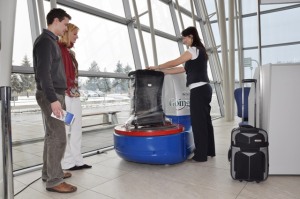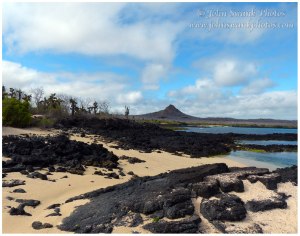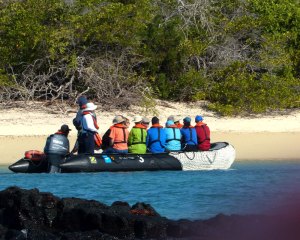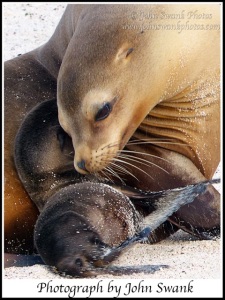
Recent air travel has left me mildly ranting, to myself mostly. All the usual problems and challenges accrued, but it was worth it to arrive in the Galapagos, even though I hate-loved the shabby tin-roofed open air airport in Banquerizo Moreno on San Cristobal Island. They are building a new airport. Too bad, because in the old one the incoming passengers can listen to the outgoing passengers, who are just on the other side of a flimsy wall. They sounded mellow and friendly and on our side we were quiet and excited. Since there is only one flight in and out each day, the old airport has a certain atmosphere–like an inhale and an exhale, only magnified and quite wonderful.

The Aerogal airplane we flew in on had an iguana on it’s tail. So did a little envelope of salt we got with breakfast. I saved it.

About the shrink wrap. In Miami and in Guayaquil you could have your checked luggage shrink wrapped in tinted plastic. I mean really wrapped, mummy-style. Your suitcase was placed on a pedestal that revolved as attendant spun it, each revolution adding a new layer. It was a pretty cool machine, but I had no idea why it was needed. Are that many folks in need of repacking and jettisoning stuff that made their luggage bulge? Had their luggage just burst? No, it seems shrink wrap was for certain destinations. Health and Safety? I guess…the destinations were Cuba and Brazil. Figure it out. Think hard. Think about what kind of sharp tool would be needed to cut through layers of shrink wrap. Think about yourself– struggling at the other end, after thieves had not been successful. Normal packaging often makes me crazy, but layers of plastic wrap must take a machete. Not to mention the waste inherent in so much plastic wrap. We just can’t seem to use up those oil-based products fast enough.
Back in the Galapagos, we filed out of the flimsy tin airport and boarded buses, which took us to the pier. There, we waited for the Zodiacs, our limos to the Endeavour, our mother ship, which was anchored off shore. The benches in the gazebo and harbor park were all taken. By sea lions. Magnificent Frigatebirds soared overhead, bright red and yellow crabs clung to black volcanic rocks and the Pacific was pure blue. It was a wonderful beginning.
No shrink wrap required.











